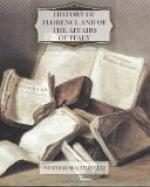While Ferrando was encamped in the Chianti he made many incursions, and took considerable booty from the Florentine territories, extending his depredations within six miles of the city, to the great alarm and injury of the people, who at this time, having sent their forces to the number of eight thousand soldiers under Astorre da Faenza and Gismondo Malatesti toward Castel di Colle, kept them at a distance from the enemy, lest they should be compelled to an engagement; for they considered that so long as they were not beaten in a pitched battle, they could not be vanquished in the war generally; for small castles, when lost, were recovered at the peace, and larger places were in no danger, because the enemy would not venture to attack them. The king had also a fleet of about twenty vessels, comprising galleys and smaller craft, which lay off Pisa, and during the siege of Castellina were moored near the Rocca di Vada, which, from the negligence of the governor, he took, and then harassed the surrounding country. However, this annoyance was easily removed by a few soldiers sent by the Florentines to Campiglia, and who confined the enemy to the coast.
CHAPTER VI
Conspiracy of Stefano Porcari against the papal government—The conspirators discovered and punished—The Florentines recover the places they had lost—Gherardo Gambacorti, lord of Val di Bagno, endeavors to transfer his territories to the king of Naples—Gallant conduct of Antonio Gualandi, who counteracts the design of Gambacorti—Rene of Anjou is called into Italy by the Florentines—Rene returns to France—The pope endeavors to restore peace—Peace proclaimed—Jacopo Piccinino attacks the Siennese.
The pontiff did not interfere in these affairs further than to endeavor to bring the parties to a mutual accommodation; but while he refrained from external wars he incurred the danger of more serious troubles at home. Stefano Porcari was a Roman citizen, equally distinguished for nobility of birth and extent of learning, but still more by the excellence of his character. Like all who are in pursuit of glory, he resolved either to perform or to attempt something worthy of memory, and thought he could not do better than deliver his country from the hands of the prelates, and restore the ancient form of government; hoping, in the event of success, to be considered a new founder or second father of the city. The dissolute manners of the priesthood, and the discontent of the Roman barons and people, encouraged him to look for a happy termination of his enterprise; but he derived his greatest confidence from those verses of Petrarch in the canzone which begins, “Spirto gentil che quelle membra reggi,” where he says,—
“Sopra il Monte Tarpejo canzon vedra, Un cavalier, ch’ Italia tutta onora, Pensoso piu d’altrui, che di se stesso.”




